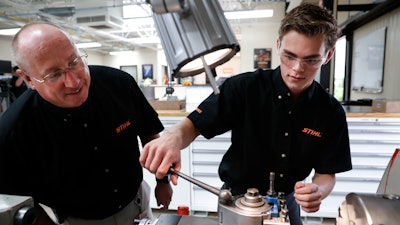
WASHINGTON (AP) — U.S. factories expanded at a brisk pace in August, a likely sign of strength for the U.S. economy as new orders, production and employment all improved.
The Institute for Supply Management said Friday that its manufacturing index rose to 58.8 percent last month from 56.3 percent in July. Anything above 50 signals that factory activity is increasing.
The measure now stands at its highest level since April 2011, pointing to solid economic growth.
Fourteen of eighteen manufacturing industries surveyed by ISM posted growth in August, including the machinery, petroleum and coal products, and computer and electronic products sectors.
August was "a really strong month," Timothy Fiore, chair of ISM's manufacturing business survey committee, said in a telephone interview. He noted that the growth was mostly driven by the top manufacturing sectors.
It's early to predict the impact on the oil, gas and chemical industries and on the broader economy of Hurricane Harvey. But Fiore said a snap survey of ISM members showed there likely will be a significant hit to the petroleum and chemical products sectors and "lots of supply chain disruptions."
Refining capacity, raw materials and the ability to deliver products all have been drastically affected by the storm that lashed Houston and nearby areas and shut down oil refineries, plastics plants and the Houston port — the second-busiest in the nation. There have been widespread reports of gasoline shortages.
The chemical products sector is one of the six biggest manufacturing industries, accounting for 17 percent of total activity, Fiore noted. Petroleum and coal, also among the "Big Six," account for 7 percent. Texas represents more than 10 percent of U.S. manufacturing production. Chemical products refining in the state accounts for 20 percent of the U.S. total, and oil and gas represents 30 percent.
U.S. factories have largely recovered from a slump in late 2015 and early 2016 caused by cutbacks in the energy industry and a strong dollar, which makes U.S. goods more expensive in foreign markets. Manufacturing employment began a sustained turnaround in December and enjoyed four additional months of job gains, only to have factories shed 1,000 workers in May.
New government data issued Friday showed that manufacturing was one of the leading sources of U.S. job growth in August, adding 36,000.
For August, the manufacturing production component of the ISM index rose 0.4 point to a reading of 61 in August. Employment climbed 4.7 points to 59.9 percent. The component of prices for raw materials was unchanged at 62 percent.





















